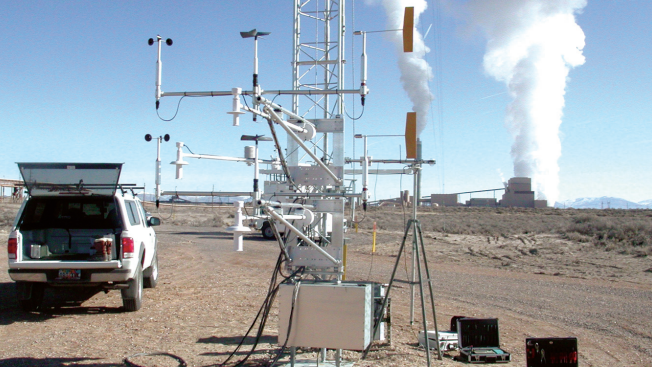


過去数年間、電力業界では、ユタ州の天然資源を電力生産にもっと活用しようと奮闘してきました。提案された施設を建設するために必要な許可を得るために、電力会社は、現場の状況を表す最新の気象データと大気質データを使用して、提案された発電所の敷地からの排出物をモデル化する必要があります。Metalotical Solutions, Inc. (MSI) は、ユタ州の提案された発電所または既存の発電所の敷地の基準条件を特徴付ける気象および大気質監視システムを設置して運用しました。最低 1 年間の有効なデータが必要であり、高いデータ回復率を保証するために厳格な品質管理措置が実施されています。データは、Campbell Scientific CR23X データロガーを使用して 1 秒値から計算された 15 分間の平均値として収集および保存されます。信頼性の高い固定電話または携帯電話接続により、設置されたデータロガーを頻繁に照会してデータを取得し、データの有効性を確認することができます。Campbell Scientific のデータロガーソフトウェアは、データの取得、数値のリアルタイム表示、およびデータロガープログラムの変更に使用されました。
これらすべての用途において、気象センサーは 50 メートルまたは 100 メートルのタワーに取り付けられました。風速センサーと温度センサーは、100 メートルまたは 50 メートルと 10 メートルの電動計器リフト台車のブームに取り付けられました。この機能により、定期的なメンテナンスや半年ごとのパフォーマンス監査の際にセンサーにアクセスしやすくなり、タワーに登る必要がなくなりました。タワー センサーの構成には、10 メートルと 50 メートルまたは 100 メートルで風速と風向を測定する 010C/020C センサーと、2 メートル、10 メートル、50 メートルまたは 100 メートルのレベルでモーター吸引シールドを備えた RTD 温度プローブが含まれていました。この配置により、さまざまなデルタ温度計算が可能になり、さまざまな分散モデル入力要件を満たすことができました。LI200X は太陽放射を測定し、CS105 は気圧を測定しました。
すべてのタワーには、EPA 承認の ISCST 拡散モデルに入力するデータを収集するためのセンサーが装備されています。2 つのタワーには、EPA 承認の AERMOD および CALPUFF 拡散モデルのデータ入力要件を満たすための追加のセンサーが装備されています。これには、気温と相対湿度用の HMP45C センサー、Q7.1 ネット放射計、転倒桝式雨量計が含まれます。
大気の安定性は、3 つの異なる方法を使用して計算されました。シグマ シータ (σθ) は、1 秒データから CR23X によって計算され、15 分ごとに保存され、後でシグマ シータ法を使用して大気の安定性を計算します。大気の安定性を計算するための太陽放射デルタ温度 (SRDT) アプローチでは、垂直風速測定を使用するシグマ W アプローチと同様に、MSI による 15 分間の平均データの処理が必要でした。
現場の測定システムに関する最新情報を維持し、高いデータ復旧率 (通常 98 パーセント以上) を保証するために、COM210 電話モデムまたは COM100 携帯電話パッケージを使用して、可能な限り毎日データ ロガーを調べました。現場のデータ ロガーを調べ、最後の通話以降に保存されたすべてのデータを取得した後、ソルト レイク シティの MSI コンピューターにデータを保存しました。データ検証プロセスは、このデータが、USEPA ガイドライン基準に基づいて MSI が開発したプログラムを使用して、一連のパラメータ固有の品質テストに自動的にかけられたときに開始されました。プログラムは、リストされたテストの 1 つ以上に合格しなかったデータ ファイルの各値を識別するレポートを生成しました。さらに、一連の積み重ねられた時間パラメータ プロットが作成され、空気品質気象学者がデータの不規則性を視覚的に検査または検索し、パラメータの相互関係を評価し、修正措置が必要かどうかを判断できるようになりました。適切な場合は、現場技術者ができるだけ早く現場に派遣され、問題を修正しました。
モーター吸引式温度シールドの適切な動作を確認するための品質管理対策として、シールドには CR23X のコントロール ポートとインターフェイスするフロー スイッチが装備されていました。吸引式シールドを通る流れが (氷結やクモの巣などにより) 妨げられると、コントロール ポートに接続されたスイッチがデータ ロガー プログラムにカウンターを増分するように指示しました。品質管理プログラムは、そのカウントをデータ編集基準を満たさないパラメーターとして登録し、現場の技術者が是正措置を開始しました。
大気ガス サンプリング装置の品質管理には、定期的なゼロ、スパン、精度のチェックが含まれます。これらのチェックは、A21REL-12 リレー ドライバーに接続され、ガス分析装置キャリブレーション システムとインターフェイスされた CR23X 制御ポートによって起動できます。マイクロプロセッサに RS-232 接続されたガス分析装置とキャリブレーション装置では、モデム経由でシステムにリモート アクセスすることができます。ある大気質監視ステーションでは、MSI はコード起動スイッチを使用して、CR23X だけでなくガス監視装置にも選択可能な電話アクセスを使用しました。この機能により、分析装置とリアルタイムで通信して、リモートで診断を表示し、問題をトラブルシューティングできるようになりました。